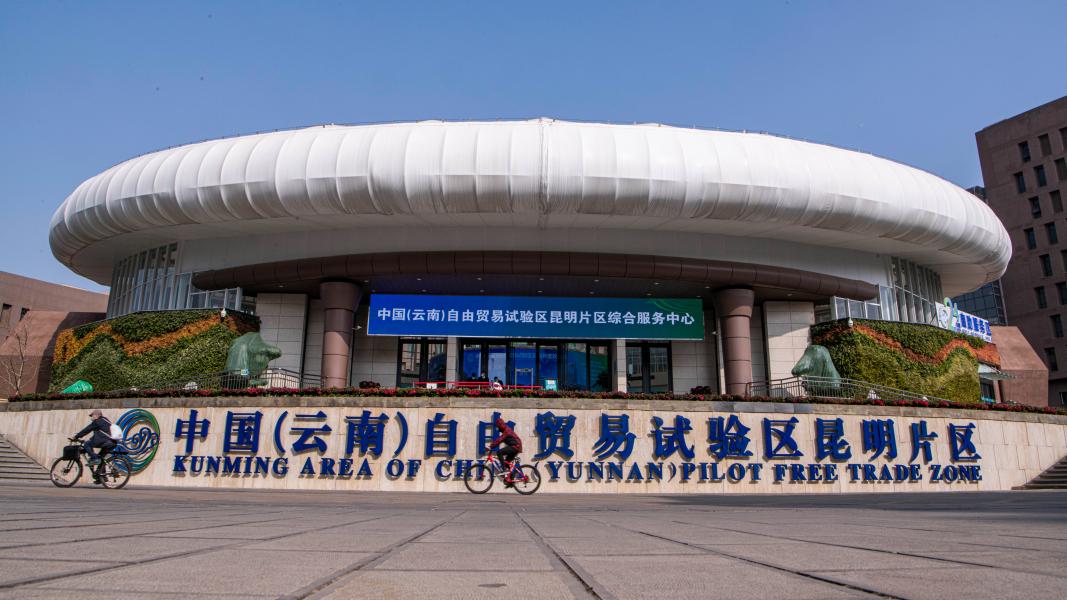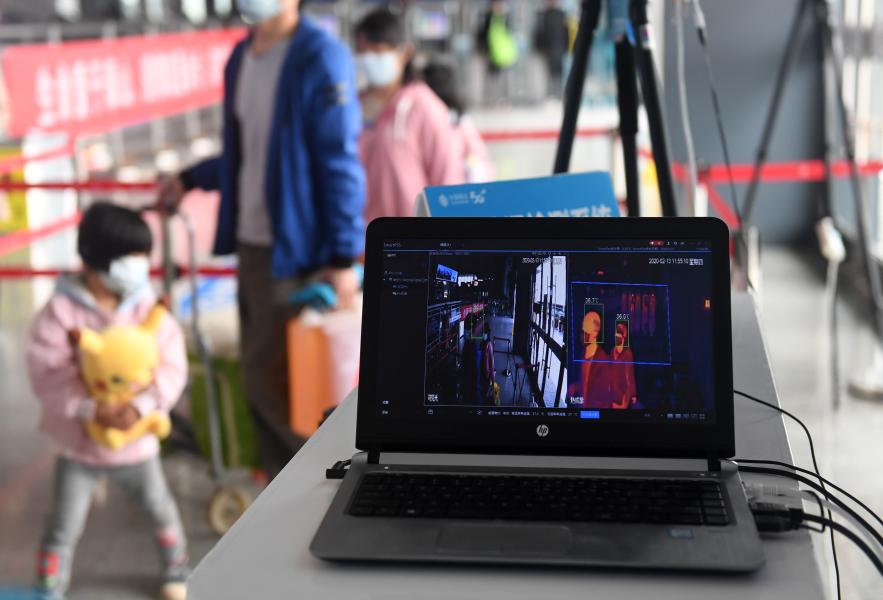

-- Nearly 30 provinces, autonomous regions, and municipalities have set this year's economic growth target at more than 6 percent.
-- The keywords at China's local legislative sessions, such as 5G use, digital currency, and carbon peak, highlight the country's new momentum for its high-quality growth.
BEIJING, Feb. 3 (Xinhua) -- As of Wednesday, most provincial-level regions had held their annual legislative sessions, putting forward new keywords in their development blueprints for this year and the coming five years.
The new buzzwords, such as 5G use, digital currency, and carbon peak, highlight the country's new momentum for its high-quality growth in line with China's new development philosophy and paradigm.
GROWTH TARGETS
Nearly 30 provinces, autonomous regions, and municipalities have set this year's economic growth target at more than 6 percent.
Guangdong, Jiangsu, and Shandong provinces, among the country's major economic powerhouses, aimed for a more than 6 percent expansion in 2021. The growth targets of other provincial-level regions generally range from more than 6 percent to more than 9 percent.
Central China's Hubei Province, hit hard by COVID-19 last year, and the southern Hainan Province targeted a double-digit growth of more than 10 percent.
The local growth targets showed the resilience and potential of China's economy. It adds certainty to the world amid a global recession, said Liang Qidong, vice president of the Liaoning Academy of Social Sciences.
Growing 2.3 percent year on year in 2020, China's economy will likely see a faster recovery and mild transitions in macro-policies in 2021, a year of multiple challenges at home and abroad, according to Zhang Yuxian, an expert with the State Information Center.
DUAL CIRCULATION
The "dual circulation" development pattern, in which domestic and overseas markets reinforce each other, with the domestic market as the mainstay, was another keyword phrase in this year's local government reports.
Liaoning Province in northeast China said it would actively integrate its development into this paradigm, building itself into a central hub for economic and trade cooperation in Northeast Asia. The province will also introduce new reforms in its free trade zone and accelerate Sino-German and Sino-UK industrial park construction.

An exterior view of a service center in Kunming Area of China (Yunnan) Pilot Free Trade Zone in Kunming, southwest China's Yunnan Province on Jan. 28, 2021. (Xinhua/Jiang Wenyao)
Southwest China's Yunnan Province will beef up efforts to advance reform and opening-up by relying on its free trade zone. Xinjiang Uygur Autonomous Region and Inner Mongolia Autonomous Region also unveiled plans to apply for a free trade zone in their government work reports this year.
The Regional Comprehensive Economic Partnership (RCEP) would increase the cooperation between China and the Association of Southeast Asian Nations (ASEAN). This would be favorable for Yunnan to expand opening-up, said Ma Yong, head of the Institute of Southeast Asian Studies at the Yunnan Academy of Social Sciences.
CARBON PEAK
Amid the country's all-out efforts to meet its 2060 carbon-neutral target, provincial authorities said they would formulate action plans to achieve carbon emission peaks by reducing emissions and expanding renewable energy usage, among other measures.
Shanghai aims to bring the city's carbon dioxide emissions to a peak before 2025. It would be five years ahead of the national target of 2030, according to the municipal government.

Electricians check photovoltaic solar panels in Sheyanghu Township of Baoying County, east China's Jiangsu Province, Nov. 5, 2020. (Xinhua/Li Bo)
Liaoning province said it would compile and implement an action plan for carbon emission peaks through developing renewable energy such as solar and wind power, afforestation, and promoting the carbon trading market.
Provinces such as Jiangsu and Guangdong also vowed to take the lead in peaking their carbon emissions.

The office of China Emissions Exchange (Guangzhou) in Guangzhou, south China's Guangdong Province. (China Emissions Exchange (Guangzhou)/Handout via Xinhua)
China has announced that it will strive to bring carbon dioxide emissions to a peak before 2030 and become carbon neutral before 2060. One priority is to adjust energy and industrial structures to meet the carbon peak target, and it is necessary to take a differentiated and inclusive approach, experts say.
DIGITAL CURRENCY
Beijing, Shanghai, and Guangdong plan to promote digital currency pilot applications in their local government work reports.
Beijing will accelerate innovation demonstration zone construction for fintech and professional services. The city will also advance the pilot use of digital currency, Mayor Chen Jining said. He made the comments while elaborating on the significant tasks this year in the municipal government work report. Guangdong plans to support Shenzhen in building a pilot zone for digital currency innovation.
Shenzhen, Beijing, and Suzhou have all piloted the digital yuan since last year. Efforts are underway to include more people in this fast-developing digital era, making daily life easy and digital payments more secure.
5G USE
China is accelerating its pace to construct information infrastructure for the 5G era to boost production and consumption upgrades.

Passengers' body temperature information is displayed on the monitor of a 5G body temperature screening system at Nanning East Railway Station in Nanning City, south China's Guangxi Zhuang Autonomous Region, Feb. 13, 2020. (Xinhua/Lu Boan)
Guangdong will have 220,000 5G base stations by 2022, with its 5G users reaching 60 million. Guangxi Zhuang Autonomous Region plans to build 20,000 5G base stations this year and expand the 5G network in cities, counties, and townships. Southwest China's Guizhou will support the applications of 5G and artificial intelligence.

The opening of the World 5G Convention in Guangzhou, south China's Guangdong Province on Nov. 26, 2020. (Xinhua/Deng Hua)
14th FIVE-YEAR PLAN
The year 2021 marks the start of the 14th Five-Year Plan (2021-2025) period, with the country embarking on a new journey of fully building a modern socialist country. The local legislative sessions also reviewed and adopted the provincial-level 14th five-year plan outlines.
The economic growth targets and measures to implement the national development strategies and policies are included in the local 14th five-year plans, with high-quality development, innovation, and opening-up among the most significant aspects of regional development blueprints.
ANTI-POVERTY CAMPAIGN
In 2020, all the remaining poverty-stricken counties across the country were delisted despite the COVID-19 impact, marking a decisive victory in the country's tough battle against poverty.

Villagers are seen at a square in Simola Wa Village in Qingshui Town of Tengchong City, southwest China's Yunnan Province, May 15, 2020. (Xinhua/Hu Chao)
Places such as Yunnan, Guizhou, and Sichuan have announced measures to consolidate the poverty reduction outcomes and promote rural vitalization at the local legislative sessions.

A sales assistant (L) and a resident relocated from a poverty-stricken area observe a batik product at a batik workshop in Danzhai County of Guizhou Province in southwest China, Dec. 1, 2020. (Xinhua/Yang Ying)
Yunnan plans to build 100 demonstration townships and 10,000 "beautiful villages" among its efforts to vitalize the rural areas and improve the rural residents' living environment.

 Award-winning photos show poverty reduction achievements in NE China's Jilin province
Award-winning photos show poverty reduction achievements in NE China's Jilin province People dance to greet advent of New Year in Ameiqituo Town, Guizhou
People dance to greet advent of New Year in Ameiqituo Town, Guizhou Fire brigade in Shanghai holds group wedding
Fire brigade in Shanghai holds group wedding Tourists enjoy ice sculptures in Datan Town, north China
Tourists enjoy ice sculptures in Datan Town, north China Sunset scenery of Dayan Pagoda in Xi'an
Sunset scenery of Dayan Pagoda in Xi'an Tourists have fun at scenic spot in Nanlong Town, NW China
Tourists have fun at scenic spot in Nanlong Town, NW China Harbin attracts tourists by making best use of ice in winter
Harbin attracts tourists by making best use of ice in winter In pics: FIS Alpine Ski Women's World Cup Slalom
In pics: FIS Alpine Ski Women's World Cup Slalom Black-necked cranes rest at reservoir in Lhunzhub County, Lhasa
Black-necked cranes rest at reservoir in Lhunzhub County, Lhasa China's FAST telescope will be available to foreign scientists in April
China's FAST telescope will be available to foreign scientists in April